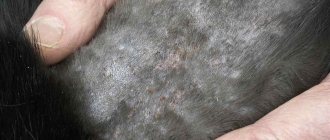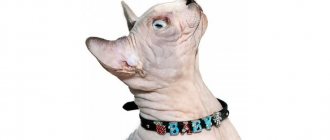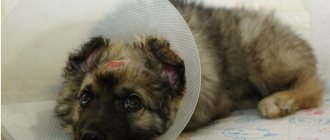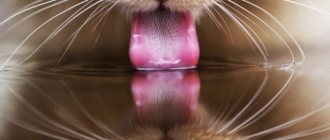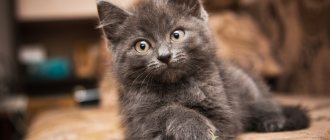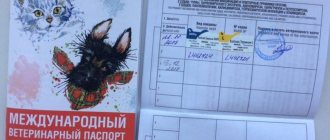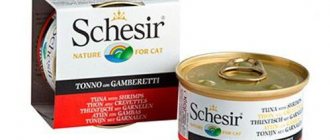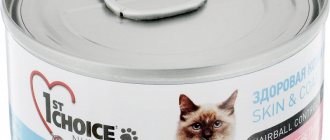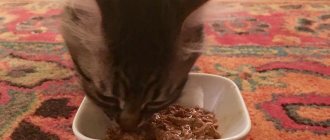≡ 5 August 2020
← I learned this in a Soviet kindergarten
Russian indifference →
For adult cats, it is recommended to calculate the diet based on 70 kcal and 10 g of protein per 1 kg of body weight. The cat owner can cook the food himself or buy it ready-made. It will be best if you start accustoming your cat to a variety of foods from an early age, which will further eliminate the problem of properly balancing the diet. An adult cat should be given 150-200 g of food containing protein - meat, fish, eggs, cottage cheese, soy flour, yeast. Carbohydrate-containing products - 50 g, including non-digestible ballast substances: rice, rolled oats, buckwheat.
In their raw form, the cat digests meat and fish well, but it is better to heat carbohydrate-containing foods for better digestibility by the body.
Chocolate, sweets, all kinds of smoked meats, pates, pickled foods, canned food, and foods with spices are contraindicated for cats. The amount of food a cat needs depends on a number of factors. So, a young growing organism needs more food than the body of an adult cat.
The amount of feed is affected by:
• weight of the cat, • body size, • mobility of the animal, • living conditions, • environment.
It should be taken into account that among cats there are individuals with poor appetite. In such cases, we are not talking about the functions of its digestive organs, but about the individual qualities of the cat and depends on metabolism. Thus, due to castration, metabolism often changes and feed consumption decreases. When you purchase a purebred kitten, you should be provided with the necessary information about the rules for keeping and feeding the pet.
Of course, it is very important to know what the composition of food and feeding frequency should be for the normal development of a growing organism.
Cats must develop a clear diet. At the age of 2.5-3 months, meals should be 5-6 times a day. At 4-5 months - 5 times a day, and at 6-8 months the number of feedings is reduced to 3 times. From 9 months and above, meals should be 2 times a day.
The best time for feeding is 8-9 o'clock in the morning and 6-7 o'clock in the evening, since these hours are the period of increased cat activity.
The dishes your cat eats from should always be clean and different from the ones you use. If you use the same plates or bowls, then perhaps the cat will take charge of your table, thinking that her bowl is there.
How many times you feed your cat is up to you. Maybe it will be once, or maybe several times a day. It all depends on the personality of your pet. You can also leave out dry food for her at all times so she can eat whenever she wants.
Barley porridge with pieces of chicken breast and carrots
For 1 serving, g:
Chicken breast 100 Barley 50 Carrots 20 Water 15
The breast fillet is separated from the bones and cut into small, small cubes or minced in a meat grinder and frozen. When barley is boiled, to cook it faster, soak it overnight. Grate the carrots on a coarse grater (boil first). Mix chicken fillet scalded with boiling water, carrots, porridge (you can use your own proportions). + a little boiling water to make it softer and warmer.
In 1 serving:
| Belki, city | Fats | Carbohydrates |
| 8,2 | 6,6 | 9,9 |
Energy value: 177kcal.
Chemical composition per 100g.
| Belki, city | Fats | Carbohydrates |
| 9,8 | 3,6 | 5,3 |
Energy value: 95.7 kcal.
Boiled chicken with porridge
For 1 serving, g:
Chicken fillet 100
Oatmeal (rolled oats)
70
Chicken broth
100
Boil the chicken meat, chop it, put it in a bowl. Add crushed rolled oats flakes there. Pour chicken broth and microwave for a couple of minutes.
In 1 serving:
| Belki, city | Fats | Carbohydrates |
| 18,7 | 7,4 | 10,9 |
Energy value: 190.3 kcal.
Chemical composition per 100g.
| Belki, city | Fats | Carbohydrates |
| 6,9 | 2,7 | 4,0 |
Energy value: 70.5 kcal.
Cat pancakes
For 1 serving, g:
Beef 100
Carrot
50
Salad
10
Egg
1 pc.
Vegetable oil
~5
Grate the frozen beef on a coarse grater + raw carrots on a fine grater + chop the lettuce with a knife. Add a crushed calcium tablet (calcium gluconate) and a few drops of vegetable oil. Beat in the egg and form into cakes. Bake in the microwave on low until the cakes set. You can put it in the freezer and take it out as needed.
In 1 serving:
| Belki, city | Fats | Carbohydrates |
| 34,4 | 37,6 | 3,1 |
Energy value: 488.7 kcal.
Chemical composition per 100g.
| Belki, city | Fats | Carbohydrates |
| 16 | 17,5 | 1,4 |
Energy value: 227.3 kcal.
Puree
For 2 servings, g.:
Cream 10% 100
Low-fat cottage cheese
70
Chicken
70
Carrots
50
Stir in a blender: 10% cream, low-fat cottage cheese, boiled chicken and carrots.
Keep refrigerated.
In 1 serving:
| Belki, city | Fats | Carbohydrates |
| 13,8 | 7,5 | 4 |
Energy value: 140.5 kcal.
Chemical composition per 100g.
| Belki, city | Fats | Carbohydrates |
| 4,7 | 2,6 | 1,4 |
Energy value : 96.9 kcal.
Delicious balls
For 2 servings, g.:
Beef (fillet) or chicken (fillet) 100
Oatmeal (rolled oats)
70
Carrots
50
Egg
1 pc.
Add boiled rolled oats, boiled carrot puree (five minutes in the microwave), and a raw egg to the ground beef or chicken (minced meat is made from beef without fat or chicken without skin). Roll into tiny balls and place them on a large board. Place in the freezer. Then pour it into a bag and twist it to remove various smells. It is very easy to defrost, because they are small)!
In 1 serving:
| Belki, city | Fats | Carbohydrates |
| 15,5 | 10,2 | 6,7 |
Energy value: 182kcal.
Chemical composition per 100g.
| Belki, city | Fats | Carbohydrates |
| 5,7 | 3,7 | 2,5 |
Energy value : 67.4 kcal.
Chicken dinner
For 12 servings, g.:
Chicken fillet 500
Chicken gizzards
500
Chicken heart
250
Cereals (wheat, barley, oatmeal, pearl barley, buckwheat, corn)
700
Carrots
500
Salad
100
Vegetable oil
~10
Boil chicken fillets, chicken gizzards, chicken hearts, cut into pieces. Boil cereals (wheat, barley, rolled oats, pearl barley, buckwheat, corn) and carrots in the broth. Mix everything. Before serving, add a couple of drops of vegetable oil and chopped lettuce. Divide the rest into bags and freeze. List of porridges with the percentage of fat in ascending order (barley, pearl barley, wheat, rolled oats, corn, buckwheat) List of porridges with the percentage of carbohydrates in ascending order (buckwheat, rolled oatmeal, wheat, barley, pearl barley, corn)
In 1 serving:
| Belki, city | Fats | Carbohydrates |
| 25,2 | 7,7~9,4 | 9,5~14,4 |
Energy value: 201.8~212.3kcal.
Chemical composition per 100g.
| Belki, city | Fats | Carbohydrates |
| 11,8 | 3,6~4,4 | 4,7~6,7 |
Energy value: :94.7~99.7kcal.
Beef dinner
For 12 servings, g.:
Beef (fillet) 1000
Beef liver
250
Cereals (wheat, barley, oatmeal, pearl barley, buckwheat, corn)
700
Carrots
500
Salad
100
Vegetable oil
~10
Boil the beef fillet and liver, cut into pieces. Boil cereals (wheat, barley, rolled oats, pearl barley, buckwheat, corn) and carrots in the broth. Continue as in the recipe above.
In 1 serving:
| Belki, city | Fats | Carbohydrates |
| 27,8 | 15,8~17,6 | 9,7~14,6 |
Energy value: 307.9~318.5kcal.
Chemical composition per 100g.
| Belki, city | Fats | Carbohydrates |
| 13,1 | 7,4~8,3 | 4,5~6,8 |
Energy value: :144.5~149.5kcal.\
Balanced nutrition options
Natural food for cats must be balanced and contain all useful substances. This will eliminate the effect of hypovitaminosis and raise a healthy cat. If food is used for a kitten, it is boiled or stewed for a long time. If the cat is an adult, you can give food raw or semi-raw.
Approximate natural food for cats with a weekly menu:
- Give dairy products 2-3 times a week;
- meat must be alternated with offal to compensate for the lack of all vitamins;
- Be sure to give clean water daily, change it 2-3 times a day;
- include vegetables in the diet, mixing them with meat, they contain a large amount of microelements, they are given 3-4 times a week;
- use cereals that normalize the digestion process.
Natural feeding of cats should include a hearty breakfast, lunch of soup or stew, and a light dinner. For example, you can give a cutlet for breakfast, chicken soup for lunch, and low-fat cottage cheese for dinner.
If the owner is worried about hypovitaminosis in his pet, he can undergo periodic laboratory tests to identify deficiencies of various substances. A good veterinarian will tell you how to eliminate hypovitaminosis or lack of microelements.
Use of eggs for food
Options for mixing natural food with store-bought food
You can also mix natural food with store-bought food. You can give dry cat food or canned food for dinner every day. For breakfast and lunch they use natural food. You should first consult with your veterinarian about what cat food to use at home with easy recipes.
Some owners give their pet a limited list of foods, so it develops various diseases. To exclude these actions, they are first examined by a veterinarian.
Choosing the right dry food
After certain procedures or surgical interventions, a diet is also used. For example, if the owner wanted to castrate a cat, after the procedure they use low-fat diet food.
In addition to dry food, you can combine natural food with canned food. They have a beneficial effect on the digestive tract. When using them, there is no possibility of the formation of stones in the gall bladder, bladder, or liver.
Attention! Canned food has a soft consistency, so it does not lead to poor digestion.
Vitamins for kittens with natural nutrition
A kitten may lack all the vitamins it gets through natural food. The veterinarian will tell you how to feed a young cat with natural food correctly. To do this, you can use separate store-bought vitamins that are added to food daily.
The owner can also choose a mixed diet. In this case, the kitten is given dry food based on vitamins in the morning. At lunchtime and in the evening he can receive natural food.
Proper nutrition for a kitten
Many owners do not know what to feed their cat with natural food. There are many dishes that can be prepared for 1 week. They contain many useful substances, the diet will be healthy and balanced.
If the owner does not know how to feed the cat natural food correctly, it is better to get advice from a specialist. You can first conduct laboratory tests to determine the functionality of internal organs. This will allow you to choose the right diet.
Calcium recipe
For 1 serving, g:
Sour cream 18% 50
Low-fat cottage cheese
50
Egg
1 pc.
Vegetable oil
~5
Mix sour cream and low-fat cottage cheese, add grated boiled egg, and eggshell powder on the tip of a knife. Mix everything, add a quarter teaspoon of vegetable oil. Give this dish 2 times a week
In 1 serving:
| Belki, city | Fats | Carbohydrates |
| 18,3 | 29,9 | 3,2 |
Energy value: 357kcal.
Chemical composition per 100g.
| Belki, city | Fats | Carbohydrates |
| 11,8 | 19,3 | 2,1 |
Energy value : 230.3 kcal.
Basic rules for healthy cat nutrition
About 90% of the diet should consist of meat and offal.
Cat dishes are served raw (with the exception of some products, which will be discussed separately) and at room temperature. It is advisable to defrost frozen portions at room temperature.
After preparing raw meat portions, place them in the freezer for at least three days. Freezing kills almost all dangerous bacteria and parasites.
Buy meat only from a trusted place.
Food should contain bones or calcium supplements.
Most of the diet should be offered in the form of pieces, since the pet must work with its jaws, tear and chew food. This is important for the cat’s health and prevents problems with teeth and gums.
Clean water should be freely available.
It is necessary to follow the feeding regimen and not exceed the portion size. An adult animal is fed twice a day, in the morning and late in the evening. The daily norm for a domestic, sedentary pet is approximately 50 g/kg of weight.
A cat's menu is much poorer than a human's. Cats are absolute predators; under natural conditions, very few grains and barely noticeable amounts of vegetables enter their stomachs. Therefore, no matter how healthy porridge, raw and baked vegetables may be for humans, they should not be included in your pet’s diet. We advise you to read the article, which describes in detail foods that are harmful to your cat’s health.
a fish dish
For 2 servings, g.:
Zander 200
Shrimp
100
Boil small pike perch and shrimp, remove bones and shell, mix and serve once a week. Can be frozen and reheated in the microwave before serving. Cats need phosphorus, but not in excess. Pike perch meat is not fatty, but is rich in nutritious and healthy fats.
In 1 serving:
| Belki, city | Fats | Carbohydrates |
| 30,7 | 2,4 | about 0 |
Energy value: 144.5 kcal.
Chemical composition per 100g.
| Belki, city | Fats | Carbohydrates |
| 20,4 | 1,6 | about 0 |
Energy value : 96.3 kcal.
Types of feed
To understand which food is more suitable for a cat than others, an attentive owner will try to familiarize himself with the composition. Dry cat food is divided into classes - premium, super-premium, economy. Of course, they differ greatly in composition.
If you want your cat to be healthy and full of energy, you should not buy food based solely on its availability.
Economy class food (for example, Whiskas, Kitikat), sold in supermarkets, is made from low-quality raw materials.
The meat content in them is 4-6%. For the most part, these are by-products, to which soy and low-grade cereals are added. Such foods contain substances that are not beneficial for the cat’s body. In addition, regular consumption of such food causes a deficiency of amino acids and vitamins in the body, which not only disrupts metabolism, but can also cause allergies, upset digestion, and other health problems are possible. Premium food is a little better in terms of quality. When making such food, good products are selected. Meat products included in the feed are used as the main source of protein. Since the body digests such foods much better, there will be less undigested waste. Meat content – 10-20%.
Super premium feed (Royal Canin). Here the composition is perfectly balanced, the nutritional value is very high, the cat’s body absorbs such food just fine. High-quality components are selected for production - turkey, chicken, lamb, eggs, and cereals. Such foods do not contain synthetic additives, and meat makes up the majority of them.
Carefully study the composition indicated on the packaging - among the ingredients there may be not only useless, but also downright harmful.
Beef with vegetables
For 1 serving, g:
Beef (fillet) 100
Cabbage
20
Cucumbers
20
Zucchini
20
Seaweed
20
Egg
1 pc.
Fish fat
Grind beef and vegetables (cabbage, cucumbers, zucchini) in a meat grinder. Add egg, fish oil, seaweed and vitamin complex. Instead of beef you can use: chicken liver, heart and kidneys. Liver and seaweed can cause darkening of the body in colored cats. (Barf system)
In 1 serving:
| Belki, city | Fats | Carbohydrates |
| 28,8 | 29,2 | 3,6 |
Energy value: 392.2 kcal.
Chemical composition per 100g.
| Belki, city | Fats | Carbohydrates |
| 12 | 12,2 | 1,5 |
Energy value : 163.4 kcal.
Sample menu of natural products
To make the owner’s life easier, they are developing a sample menu for 1 week:
- First day. For breakfast, a small amount of low-fat cottage cheese. For lunch, chicken soup with some vegetables added. You can grind everything in a blender. For dinner milk or kefir.
- Second day. For breakfast, cottage cheese with the addition of yogurt. For lunch they serve meat stew with the addition of vegetables. For dinner - fermented baked milk.
- The third day. Breakfast – chicken pate. Lunch – offal with cereal. Dinner: low-fat yogurt.
- Fourth day. Breakfast – low-fat cottage cheese. Lunch: liver with broccoli. Dinner – chicken soup.
- Fifth day. Breakfast - meat soup with semolina and yolk. Lunch - milk. Dinner – chicken pate.
- Sixth day. Breakfast – fresh or boiled fish. Lunch – beef cutlet. Dinner - milk.
- Seventh day. Breakfast – ground chicken fillet with added vegetables. Lunch – cottage cheese ice cream. Dinner – chicken puree soup with broccoli.
Attention! If your pet has diseases of the internal organs, it is advisable to choose natural cat food that is low in fat. This reduces the load on the liver and digestive tract.
Some pets may have allergies. Then the veterinarian prescribes a balanced diet that excludes the presence of antigens. For example, some cats may be allergic to chicken. Then they use rabbit, veal, beef.
If a person gets a kitten, a natural cat kit is also used for it. It is better not to use beef, as its meat is very tough. You can use veal, chicken or rabbit. The meat is boiled for a long time until it becomes soft. Dairy products are introduced gradually so as not to cause diarrhea and digestive upset.
Mustachioed tough guy
For 25 servings, g:
Beef (fillet) 1000
Chicken (fillet)
1000
Pink salmon fish
500
Rice
1000
Egg
5 pcs.
Vegetable oil
~50
Liver or heart (chicken)
1500
Clean the meat from fat, chop the chicken fillet. Separate the fish from bones and skin. Cut everything into small cubes, put it in a saucepan, add a small amount of water (so that the liquid just covers the layer of meat) and simmer over very low heat for about 1 hour. Separately, cook the rice and cook until completely cooked. Mix it with meat and eggs (up to 1/3 of the volume), add 1/4 cup of vegetable oil and heat, stirring, for another 10 minutes. Place into portioned bags and freeze. Serve cat food warm!
This dish should be used as the main food if you want to fatten an exhausted or weakened cat. After a couple of weeks, your pet’s coat will shine, his sides will become rounder, he will become cheerful and playful.
The liver contains more protein and the heart contains more fat.
In 1 serving:
| Belki, city | Fats | Carbohydrates |
| 33,2~35,2 | 19,7~22,1 | 7,5 |
Energy value: 352~365.8kcal.
Chemical composition per 100g.
| Belki, city | Fats | Carbohydrates |
| 15,6~16,6 | 9,3~10,4 | 3,5 |
Energy value: 166~172.5kcal.
Natural homemade food recipes for furry pets
Dishes for your cat can be not only healthy, but also varied. You can prepare your pet’s main meal, desserts and various pleasant treats yourself.
Many dishes prepared in this way can be poured into containers or placed in special bags and frozen. This way you will save yourself from lengthy cooking and provide your cat with a supply of food for a long time.
Recipes for preparing healthy dishes:
- Nutritious pate. Boil 0.5 kg of any meat for half an hour, then remove from the pan and add carrots and broccoli to the resulting broth. They must be cooked until half cooked. Pour boiling water over one glass of rolled oats and leave for 15 minutes, then pour out the water. Mix the meat with vegetables and oatmeal in a blender until it becomes a soft paste, add broth if necessary.
- Chicken gizzards with buckwheat. Pour half a glass of buckwheat porridge with water for a day. Boil chicken gizzards and one large carrot, then grind them in a meat grinder or using a blender. Add a small piece of butter to the porridge, pour in the gizzard and carrot pate.
- Millet porridge with turkey and vegetables. Boil small beets and carrots, peel and finely chop the raw zucchini. Divide the turkey into small pieces and cook millet porridge. Grind the vegetables together with the meat in a meat grinder, then add to the porridge. If necessary, you can dilute the dish by adding egg yolk.
- Lamb fillet with rice porridge. Grate freshly frozen lamb meat along with raw carrots. Boil the broccoli and rice in advance, then mix all the ingredients in a bowl with a small amount of olive oil.
- Beef with vegetable stew. Cut the boiled beef into small pieces, mix with baked pumpkin, stewed carrots and zucchini, pour in meat broth.
My cat really loves stewed liver: this dish ranks almost first among her taste preferences. The recipe is quite simple. Cut the liver into small pieces, grate the carrots, chop the green onions. Pour some water into a small frying pan, add all the ingredients and simmer for 20-25 minutes. It turns out to be a quite tasty and nutritious dish that can be mixed with any porridge.
How to prepare a healthy and tasty treat for your furry baby:
- Beef patties. On a fine grater, grate frozen beef (about 200 g), one large carrot, 3 lettuce leaves and 30 g of celery. Add 2-5 drops of olive oil and stir, then beat one egg into the mixture. Form thin cakes, place them on baking paper and bake at a temperature of about 140 degrees until they are golden brown.
- Curd balls. Take thick cottage cheese with 1-2% fat content, mix it with a few tablespoons of sour cream. Form small balls and place them in the refrigerator for a couple of hours to set.
- Chicken with cheese. Peel the skin from the chicken breast, then cut into small pieces. Place it in the oven at 150 degrees, grating no more than 1 tablespoon of hard, lightly salted cheese on top.
Carpets "Liver"
For 5 servings, g.:
Beef liver 500
Eggs
2 pcs.
Oatmeal (flakes)
300
Grind the liver in a blender until pureed. Add eggs and mix well. Combine this mass with oatmeal. Place a sheet of foil on a baking sheet (so that the gingerbreads do not stick to the surface), roll out the dough to a layer of slightly less than a centimeter. Place in an oven preheated to 200 degrees and bake for 30 minutes. Cut the hot cake into pieces 1 cm x 1 cm, cool, pour into a jar with a lid.
Store in the refrigerator.
In 1 serving:
| Belki, city | Fats | Carbohydrates |
| 30,3 | 13,7 | 45,8 |
Energy value: 415kcal.
Chemical composition per 100g.
| Belki, city | Fats | Carbohydrates |
| 16,8 | 7,6 | 25,4 |
Energy value : 230.5 kcal.
DIY canned food for cats: preparation method
Canned food for cats is preserved in glass jars with a capacity of 0.5-1 liters, which are closed with tin lids.
First, the jars and lids are thoroughly washed and boiled.
The meat and sauce/broth are placed in the jar hot; there should be about 2 cm between the meat and the lid so that the canned food does not squeeze out the latter, compromising the integrity of the jar.
After sealing the jars, they are sterilized in a large saucepan, autoclave or pressure cooker at a temperature of 115-120 C for 1.5-2 hours. In this case, the jars are immersed in already warm water.
Canned meat and fish should be stored at a temperature of 10-15 C.
Homemade chicken liver
For 1 serving, g:
Chicken liver 100
Cheese (mild, unsalted)
30
Banana
30
Carrots
20
Oatmeal (flakes)
50
Cream
20
Vegetable oil
~10
Grate the cheese on a coarse grater, mix with carrots - also grate on a coarse grater, simmer lightly in oil, add finely chopped banana, then cream and bring to a boil. Add finely chopped liver, stir and immediately remove from heat. Add oatmeal and mix everything well.
In 1 serving:
| Belki, city | Fats | Carbohydrates |
| 29,3 | 23,5 | 44,5 |
Energy value: 495.5 kcal.
Chemical composition per 100g.
| Belki, city | Fats | Carbohydrates |
| 11,7 | 9,4 | 17,8 |
Energy value : 198.2 kcal.
Examples of natural food at home for cats
There are many simple recipes that can be used to prepare suitable food for your cat's diet. They are made in large portions, which are then frozen for 1 week.
Feeding with natural products
Doctors warn that the animal must receive all the useful substances so that the internal organs are not damaged and function normally. This is especially true for the digestive tract.
Choosing a diet for a kitten
For busy people
For 7 servings, g.:
Beef (fillet) 1000
Carrots
200
Cheese (mild, unsalted)
200
Egg
1 pc.
Grind the beef in a meat grinder, grate carrots (without nitrates) on a fine grater, cheese (mild, unsalted) on a coarse grater, raw chicken yolk (or 3 quail yolks) for binding, a tablespoon of brewer's yeast (this is the entire group of vitamins B from B1 to B12), calcium gluconate - 6 tablets (grind to powder), vitamin D - 20 drops.
The amount of meat can be increased 2-5 times, correspondingly increasing the amount of other products.
Use your hands to turn the entire mixture into a homogeneous mass. Roll out with a rolling pin into 0.5 mm layers and put in the freezer. A layer of parchment or foil is a layer of mixture.
We came home from work. Tear off a piece, quickly defrost it, make small meatballs, which increase in quantity as the cat ages.
In 1 serving:
| Belki, city | Fats | Carbohydrates |
| 33 | 8,8 | 2,4 |
Energy value: 223kcal.
Chemical composition per 100g.
| Belki, city | Fats | Carbohydrates |
| 15,9 | 4,3 | 1,2 |
Energy value : 107.7 kcal.
Canned food
A healthy diet based on fish or meat is the most optimal for a pet’s daily diet. Therefore, it is imperative to give ready-made food in dry or canned form to your cat.
You cannot talk about the benefits or harm of certain types of food, which ones are good and which ones are bad. You just have to know that products prepared in sealed packages contain a large percentage of sugar and salt, which are necessary for preservation. An animal does not need such quantities of these components for daily consumption.
Excess sugar can lead to the development of periodontal disease and gingivitis in cats. Which will then lead to inflammation of the gums and further loss of teeth.
Meat porridge with vegetables
For 6 servings, g.:
Round lake rice 100
Buckwheat-prodel
100
Carrots
50
Cauliflower
50
beans
50
Chicken
300
Beef kidneys
300
Beef heart
300
Take short-grain rice and buckwheat-prodel in equal parts, cook the crumbly porridge in water without salt. In a separate saucepan, boil the vegetable mixture (sold frozen) and preferably one without bell pepper or very little of it. The vegetable mixture may consist of carrots, cauliflower, green beans, and broccoli. So, we cooked it. In a separate container, you can boil chicken liver (then crush) or beef kidneys, or beef heart (cleansed of fat), or other offal. Everything except the chicken liver is turned through a meat grinder. You shouldn’t get carried away with liver - it weakens you, but you can add more of the rest of the meat.
Scrolled, now mix the porridge, vegetables and meat together. If the broth is rich from meat, then there is no need to add oil. If you are very lean, then you can add vegetable. Keep refrigerated.
In 1 serving:
| Belki, city | Fats | Carbohydrates |
| 26,2 | 6,9 | 6,6 |
Energy value: 193.9 kcal.
Chemical composition per 100g.
| Belki, city | Fats | Carbohydrates |
| 12,6 | 3,3 | 3,2 |
Energy value : 93.1 kcal.
Cats, by their physiology and type of metabolism, are exclusively carnivores, since during evolution their diet included a large amount of proteins and fats of animal origin. These are predators, both in terms of nutrition and behavior, so they have certain characteristics in their nutritional needs:
— The first feature is dependence on the amino acid arginine. This amino acid is found only in proteins of animal origin.
— The second feature is the dependence of cats on the aminosulfonic acid taurine. A deficiency of taurine in food causes dysfunction of the nervous and cardiovascular systems, as well as a decrease in reproductive capacity in cats. Taurine is found in fish (especially cod), beef, but there is no taurine in plant products.
— The third feature is the need for animal fats in the diet of cats, since they contain arachnidic acid, which is important for cats. But saturated and unsaturated fatty acids are found in fats, both animal and plant origin. Fats are an excellent source of energy, and fats are what make food taste and appeal to cats. Their lack in food affects the coat of animals. The fur becomes greasy and dandruff appears. Males may have a reluctance to mate. In addition, fatty acids are suppliers of fat-soluble vitamins to the body - A, D, E, K. A lack of essential fatty acids leads to hair loss, fatty liver, blood clotting disorders, and growth retardation in kittens.
Contrary to popular stereotypes and fairy tales, cats cannot eat only fish or only meat. The cat's diet should be varied. In nature, wild cats feed on small rodents and birds, and they eat them along with the skin and the contents of the stomach - grains and herbs, sometimes they come across small birds, but they practically do not get fish. Cats prefer to eat only fresh food, they do not eat carrion, unlike dogs, and they may no longer eat food that has been standing for several hours and will starve until they are given something fresh. Fasting is considered safe for a cat for no more than 1-2 days (sometimes they like to arrange fasting days for themselves or are deliberately capricious, begging for something tasty and testing the patience of their owners until they give up). But if fasting continues for more than 2 days and the cat refuses even its most favorite food, then this is a reason to consult a doctor.
To meet daily needs, each cat needs a balanced diet - a source of all nutrients (proteins, fats, minerals and vitamins).
There are 4 food groups from which you can create a balanced diet for your pet:
— Meat, offal, fish, seafood, baby meat food.
— Fermented milk products and eggs.
- Fats and oils.
— Vegetables, cereals, herbs.
You should not give your cat food that is too hot or too cold, for example straight from the refrigerator. Because this disrupts the digestion process. The cat's body will digest food well only if it is at a certain appropriate temperature.
1. MEAT PRODUCTS. This is raw meat with veins (goulash), pre-frozen in the freezer for two days, and then thawed and scalded with boiling water (or boiled or stewed for variety) - beef, veal, minced beef (for babies under 2 months and old animals, who have dental problems), chicken meat, turkey, rabbit meat, chicken offal: well-beaten necks (for cleaning teeth), hearts, liver (give it once a week, raw liver weakens, but boiled liver, on the contrary, strengthens), stomachs, also You can give tripe if the cat will eat it. Meat and/or offal are given daily, it is better to alternate them. Minced meat should not contain salt and spices! Salt for cats is a slow-acting poison! Plants buds immediately! Meat products are cut into pieces approximately 2*2 cm in size, or larger pieces are possible. This is necessary so that the animal chews them for a while, and does not swallow them whole. The chewing process prevents tartar from forming on the teeth.
2. FISH AND SEAFOOD. Fish should only be sea fish (river fish may contain worms) - cod, hake, haddock, flounder, sardine, trout, salmon, shrimp, squid, etc., except pollock, and must be boiled and practically boneless
Feeding your furry pet
Many cat owners teach their animals to eat what they themselves eat. Such food does not fully replenish the cat’s body with useful microelements and vitamins. But a pet, like a person, needs a complete, sufficiently high-calorie diet.
Pet food manufacturers produce a wide variety of dry and wet cat foods. This takes into account the animal’s breed, gender, age and activity. For growing kittens, we recommend food balanced with the necessary amount of microelements and vitamins for the growing body.
An animal that lives only within the confined space of an apartment and does not lead an active lifestyle needs a special light diet. Such foods contain less carbohydrates and fats. The elderly also need special nutrition that is easily digestible.
It should be remembered that it is not recommended to frequently feed cats liver products. This causes them to develop urolithiasis and difficulty urinating.
About feeding fish
Some types of fish are harmful to your cats. Many fish (such as herring and carp) contain large amounts of the enzyme thiaminase when raw, which destroys vitamin B1 (thiamine) found in other foods. A lack of this vitamin can gradually lead to loss of appetite and manifestations of nervous disorders (dizziness, trembling, convulsions). Hot processing of fish destroys this enzyme.
Constantly feeding cats fatty fish can contribute to the development of another deadly disease - steatitis: subcutaneous fat, when fish is stored improperly, penetrates into the muscle tissue, causing it to become poisonous, and no amount of boiling kills this poison. Fatty fish can be given to cats as an exception.
When eating contaminated raw fish caught in certain places, specific pathogenic microbes can enter the cat's body. For example, DILPHYLLOBOTHRIUM LATUM is found in freshwater fish caught in Northern Ireland, and trout and salmon from the Pacific Northwest, off North America, contain bacteria that cause “salmon poisoning.” Crayfish in North America and South Africa contain the lung fluke PARAGONIMUS KELLICOTTI. High-quality temperature treatment of fresh fish protects against invasive diseases (caused by parasites that have entered the body).
In river and sea waters, heavily polluted by industrial and agricultural wastewater, toxic substances can accumulate in fish along the “food chain”. Eating such fish can lead to poisoning from pesticides, herbicides and heavy metals (lead, mercury and cadmium). Many heavy metals are partially transferred into water when fish is cooked.
The likelihood of developing iron deficiency anemia. Some types of fish (pollock, cod, blue whiting, hake, hake, pollock, haddock) contain trimethylamine oxide, which binds iron (coming from food) and converts it into an indigestible form. Trimethylamine oxide breaks down when fish is cooked. There is a risk of developing urolithiasis (UCD). Any fish is rich in phosphorus. And some types of fish (for example, pollock) also have a very high magnesium content. These elements are the building material for struvite urinary stones (aka tripelphosphates). Magnesium and phosphorus practically do not change their properties when heated, so the type of fish processing does not matter. But for healthy cats (without a predisposition to KSD), feeding fish 1-2 times a week is not dangerous.
BONES! They are found in any fish. There are much more of them in river fish than in sea fish, and it is extremely difficult to completely remove them. It is advisable to remove large, hard bones after cooking so that the cat does not injure the pharynx, esophagus, or stomach when swallowing. Although bones are well absorbed and are an additional source of calcium, there is an opinion that they are absorbed only in their raw form, and when cooked they clog the body.
3. CHILDREN'S MEAT FOOD. A great way to diversify your cat's menu is to give her baby food (meat, fish, vegetables, cereals). This is a well-digestible dietary product and can be fed to a cat from weaning and throughout its life. “Babushkino Lukoshko”, “Agusha”, “Tikhoretskoe”, “Nestik” (not to be confused with Nesquik), “Frutonyanya”, “Agu-Agu”, Tema and others that your cat will like.
4. Fermented milk products. They must be included in the diet - cottage cheese (Agusha, Tema or home-made), sour cream (not very fatty), not salted cheeses, such as Adygei, grain cheese (homemade), kefir, yogurt, cream, bifido products, yoghurts, etc. d. If the cat loves milk and does not have problems with stool from it, then you can include it. It is better to use baby milk, such as Agusha or goat milk. If the kitten does not like fermented milk products, in particular milk, cheese and cottage cheese, then to replenish calcium during the period of intensive growth up to the 1st year, he needs to be given calcium supplements (calcium-di, calcide, sea calcium, etc.).
5. EGGS. Only the yolk - once a week (!) (otherwise you will plant the buds from an excess of protein), raw or soft-boiled, with cottage cheese/cream, etc. - whichever the cat likes best. It is better to use raw quail eggs - 1-3 pieces per diet.
6. FATS AND OILS. Vegetable (sunflower, corn, olive, flaxseed and other oils) – 1/2 tsp. for food daily 1 rub. per day or animals (butter, ghee).
7. VEGETABLES. They give very little - 1 to 5, because... cats are not vegetarians by nature. Experienced cat breeders use vegetables exclusively for the functioning of the gastrointestinal tract, because... Plant foods, compared to meat or dairy products, are practically not digested or absorbed by the body, and therefore have no nutritional value. Vegetables such as kohlrabi, cauliflower, carrots, beets, and zucchini are scalded (or boiled) before use, grated, mixed with butter or vegetable oil and then added to meat or fish. There are also ready-made vegetable purees (for example, HIPP baby food “Assorted Vegetables”). Many cats love canned sweet corn. Cats cannot extract vitamin A from carotene like humans, so there is no point in feeding them carrots specifically for this purpose.
8. GREATS. They also need to be given very little for better bowel function, although not all cats like them and don’t really need them, because... Cats' need for carbohydrates is small and their digestibility is also low. If a cat refuses to eat cereal, then there is no need to force it. Cereals such as rolled oats, rice, semolina, except buckwheat and legumes, are boiled in water and given along with meat or fish products, adding 1/2 tsp. vegetable oil. The proportion of porridge to meat is 1 to 5. It is also good to give milk porridge to kittens, pregnant and lactating cats, also adding a little butter.
9. GREENS. Lettuce, dill, parsley, etc. - whatever the cat likes. Green grass (oats, barley, corn, etc.), which is sold in pet stores or grown yourself, should be included in the cat’s diet daily.
10. FRUIT. In most cases, cats do not like them, although there are exceptions. But you shouldn’t give them specifically to your cat. Moreover, eating them can cause the accumulation of gases in the gastrointestinal tract (flatulence) and diarrhea.
11. WATER. It must be constantly fresh, passed through a filter or settled, in a place familiar to the cat.
12. VITAMINS. There is no need to give them constantly, it is better to take courses for the prevention of vitamin deficiencies in the spring and autumn or as prescribed by a veterinarian according to indications. Because Since cats themselves synthesize many vitamins from their bodies and obtain them from quality foods, their excess can also be harmful. Good vitamins from Canina, Biorhythm, Phytamines. Or you can give brewer's yeast with garlic for 1-2 months Brevers yasts 1-2 times a year. It’s better not to buy all sorts of dummy cat treats, such as colorful mice, birds, because... they will be of no use.
WHAT NOT TO FEED A CAT: Pork, lamb - very fatty, bad for the cat’s liver. Food from our table - fried, fatty, spicy, smoked, pickled, pates, canned food intended for people, with salt and spices, sweets, flour, coffee, alcohol. This is all poison for a cat! Salt is poison for cats! Onions cause anemia in cats, no matter what form they are in (raw, boiled, fried)
So, a cat’s diet should consist of approximately 2/3 meat, fish, baby food and 1/3 other products (dairy products, cereals, vegetables, dry food and canned food). Food should only be at room temperature. Feed is given at the rate of 30-60 g. per 1 kg. cat's body weight. It is always better to feed at the same time. Access to water and green grass is constant and free.
To feed a kitten, you need to feed it several times a day, little by little, remembering that “a kitten’s stomach is smaller than a thimble.” Usually, kittens do not overeat and move away from the bowl on their own or begin to “bury” food when they are full, but there are also gluttons, and you need to keep an eye on them. Small kitten aged 3 months. You need to feed 4 times a day, gradually switching to 2 meals a day by the age of one year. The best time for feeding is associated with periods of increased activity, namely around eight to nine in the morning and six to seven in the evening.
SAMPLE CAT MENU FOR THE DAY:
— Morning: 2-3 raw quail eggs, 1 tsp. ground wheat grains or bran, 1 tsp. cottage cheese, mix everything.
— Day: Any fermented milk product.
— Evening: 120-150 lean boiled fish or meat with 2 tsp. vegetable puree or grated vegetables, 1/2 tsp. oils
You can also grind raw beef, hearts, liver, vegetables and buckwheat porridge in a meat grinder, make small cutlets and freeze. And then defrost and feed it to the cat.
On average, an adult cat weighing 4-5 kg needs 150-200 grams. feed per day.
For neutered cats prone to overweight or obese, the norm can be reduced to 120-130 g. in a day. (For example, 120 g lean meat + 30 g (2 tbsp) boiled rice + 1/2 tsp vegetable oil + 2 tsp vegetable puree).
If the cat is moderately well-fed, energetic, cheerful, with shiny and non-shedding silky hair without dandruff, it has no problems with stool (diarrhea or constipation) and bad breath - this is the main indicator of your wonderful gastronomic abilities!
And even if plaintive hungry eyes are looking at you, begging for a piece of sausage or smelling your goulash in sour cream sauce, clench your hands into fists and slowly repeat to yourself: “20 years of life! 20 years of life!” Because a cat can live this long on a healthy, properly balanced diet!
Tags: food • animals • food • cats • cats • cooking • useful • recipes
Dry food for cats and dogs: three simple recipes
Recipe No. 1
You will need:
1 tbsp. fish oil.
The heart also needs to be boiled. Instead of beef heart, you can safely use chicken hearts. Fish oil will make your pet's coat shiny. You can use olive oil instead.
Recipe No. 3
You will need:
500 g chicken hearts;
2 tbsp. l. honey;
A bunch of greenery.
Chicken hearts also need to be boiled first, then do everything according to the usual technology.
Homemade dry food will ideally fit into the diet of those animals that eat the so-called “nature” - natural nutrition. It does not contain any questionable ingredients that are dangerous to the health of pets, which is the common problem with commercial dry food.
Sources:
- Is it possible to feed dogs cat food?
Cats surprise with their habits, unpredictability and willfulness. But in order for your pet to be healthy and cheerful, with smooth and silky fur, it is necessary to provide it with adequate nutrition, enriched with vitamins and healthy supplements.


